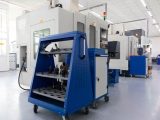
How Misusing a Telescopic Fork Reduces Work Efficiency
October 8, 2025Workplaces thrive when lifting and loading run without hiccups. Yet, habits can creep in where convenience is mistaken for reliability. Many assume that a telescopic fork solves every lifting challenge simply by existing. The truth is that blind reliance can backfire if not matched with proper planning, training, and upkeep. Let’s explore where this assumption might quietly ruin efficiency and what to do instead.
Believing One Tool Fits Every Task
It’s tempting to see the telescopic fork as a universal solution. With its extended reach, it appears to cover everything from stacking pallets to placing loads at height. The problem comes when different load sizes, weights, or awkward angles push the fork past its design limits. For instance, lifting long, unstable items without added support can cause imbalance and waste time correcting errors. Having alternative attachments available can prevent bottlenecks.
Overlooking Load Limits
Operators may assume that if the machine looks sturdy, it can handle anything. Every telescopic fork has weight ratings that change as the fork extends further. Ignoring this simple fact risks overloading, which slows down tasks and creates safety concerns. A quick check of load charts before work can save hours of disruption later. Training teams to read and apply these ratings makes the difference between smooth flow and unnecessary downtime.
Ignoring the Surface and Environment
Not all warehouse or yard floors are created equal. A telescopic fork might be stable on even ground but struggle when surfaces are uneven, slippery, or cluttered. This doesn’t just affect safety; it forces operators to work more slowly and repeat manoeuvres. Preparing pathways, removing obstacles, and considering ground conditions before moving loads allows the equipment to perform as expected. Efficiency starts with the surface under the wheels.
Forgetting About Operator Skill
The most advanced material handling equipment is only as effective as the person controlling it. A telescopic fork may look straightforward, yet operating it at full extension requires skill to avoid swaying loads or missed placements. Without proper training, operators often take longer to complete tasks, negating the machine’s intended speed. Ongoing refresher sessions can ensure everyone remains confident and capable with the equipment.
Treating Maintenance as Optional
It’s easy to think maintenance can wait until something goes wrong. A telescopic fork with worn hydraulics, damaged chains, or uneven extensions won’t just slow down tasks; it can stop them altogether. Preventive servicing ensures smooth operation and reduces the likelihood of breakdowns mid-shift. Building regular checks into the work schedule avoids small faults snowballing into costly stoppages.
Assuming Flexibility Equals Efficiency
The extending reach of a telescopic fork makes it feel flexible enough for any setup. However, reaching over racks, loading at angles, or stretching to awkward heights can actually consume more time than using different material handling equipment tailored to the task. Instead of forcing the forklift to cover everything, efficiency improves when it’s used alongside pallet trucks, conveyors, or hoists in a coordinated system.
Neglecting Safety as a Factor in Speed
Some teams cut corners to move faster, skipping stabilisation or failing to secure loads properly. This shortcut may appear to save time, but it often leads to spills, damage, or rework. A telescopic fork can only deliver efficiency when operators respect its safety measures. Ironically, the safest approach is usually the fastest in the long run, as it avoids accidents that stop production entirely.
Assuming that a telescopic fork is a catch-all answer for lifting needs can quietly undermine workflow. Efficiency suffers when load limits are ignored, training is neglected, or maintenance is delayed. The smart approach is to use a telescopic fork as part of a broader system of material handling equipment, where each tool has its place and role. By questioning the assumption that one machine solves everything, workplaces protect both safety and speed.
Contact Sunstream Industries to learn more about practical lifting solutions that align with your specific operational needs.








